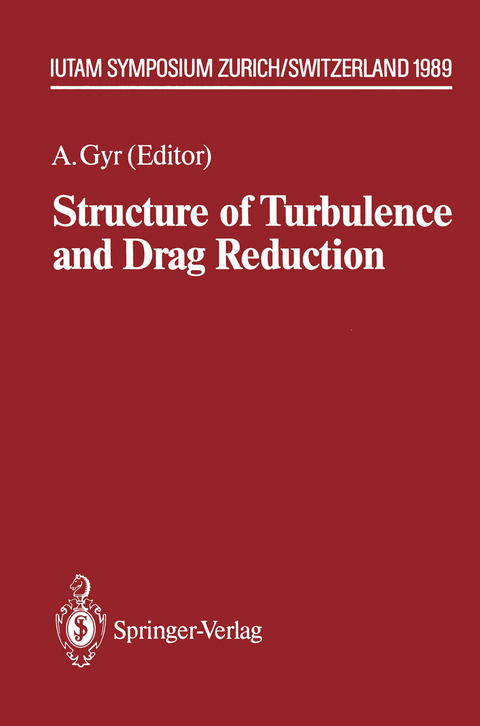
Structure of Turbulence and Drag Reduction
Springer Berlin (Verlag)
978-3-642-50973-5 (ISBN)
1 structure of Turbulence.- Reviews.- 1. Turbulent boundary layer structure: Progress, status, and challenges.- 2. A review of vortex structures and associated coherent motions in turbulent boundary layers.- Experiments in wall bounded turbulence.- 3. Hairpin vortices in turbulent boundary layers: The implications for reducing surface drag.- 4. Production of turbulence in boundary layers and potential for modification of the near wall region.- 5. Visualisation of the organized motion in a turbulent boundary layer.- 6. Analysis of experimental data on boundary layer pressure fluctuations in turbulent pipe flow.- Experinfients with free shear layers.- 7. Behaviour of separation bubble with different roughness elements at the leading edge of a flat plate.- 8. Organized structures and transition in the near field of a plane jet.- 9. Determination of regular structures in turbulent mixing processes by Raman scattering.- Theories of structures of turbulence.- 10. Wall layer eruptions in turbulent flows.- 11. Non-linear coherent mode interactions and the control of shear layers.- 12. Wavenumber-frequency spectral densities of turbulent wall pressure and wall shear fluctuations.- 13. Quadrant analysis and instantaneous momentum transport - a critical review.- 14. Artificial control of turbulent mixing layers.- 2 Drag Reduction in Dilute Polymer Solutions Injections of Concentrated Solutions.- Dilute polymer solutions Reviews.- 15. Dynamics of dilute polymer solutions.- 16. The effect of dilute polymer solutions on viscous drag and turbulence structure.- Theories of drag reduction by dilute polymer solutions.- 17. Aspects of mechanism in type B drag reduction.- 18. Change of structures close to the wall of a turbulent flow in drag reducing fluids.- Experiments with dilutepolymer solutions.- 19. The influence of polymer additives on the coherent structure of turbulent channel flow.- 20. Interaction of molecules and turbulent flow in dilute polystyrene solutions.- 21. A-shaped vortices in dilute polymer solutions.- 22. Wake flows in dilute polymer solutions.- Concentrated polymer solutions.- Review.- 23. Drag reduction caused by the injection of a polymer solution into a pipe flow.- Experiments with concentrated polymer solutions.- 24. Large eddies and polymer strings.- 25. Friction drag reduction by injection of polyethyleneoxide solution in a turbulent boundary layer through slot and perforated section.- 3 Drag Reduction by other means.- Reviews.- 26. Drag reduction in surfactant solutions.- 27. Turbulent drag reduction versus structure of turbulence.- Contributions to drag reduction by other means.- 28. Drag reduction by sand grain roughness.- 29. Effect of wall suction on the transport of a scalar by coherent structures in a turbulent boundary layer.- 30. Flow control by suction.- 31. Inertial interaction of spherical and fibre-like solid particles with turbulent flowing liquids.- 4 Stability and Computations.- Review.- 32. Hydrodynamic instability and coherent structures in turbulence.- stability.- 33. Effect of three-dimensional surface elements on boundary layer flow.- Computation.- 34. Interpretation of polymer drag reduction in terms of turbulence producing eddies close to the wall.- 35. Active turbulence control in wall-bounded flow using direct numerical simulations.- 5 Drag Reduction by Passive Means.- Review.- 36. Drag reduction by passive devices - a review of some recent developments.- Lebus.- 37. Relation between outer structures and wall-layer events in boundary layers with and without manipulation.- 38. Boundary layermanipulators at high Reynolds numbers.- 39. Large-scale turbulence structures in a manipulated channel flow.- 40. Analysis of the wake of an outer layer manipulator.- 41. Influence of an acoustic field on the flow structure behind a LEBU in a turbulent boundary layer.- 42. Analysis of the structure of a turbulent boundary layer, with and without a LEBU using light sheet smoke visualizations and hot wire measurements.- Riblets.- 43. The effects of longitudinal roughness elements and local suction upon the turbulent boundary layer.- 44. Turbulent drag reduction by nonplanar surfaces. A survey on the research at TU/DLR Berlin.- 45. Drag reduction in pipes lined with riblets.- 46. Drag reduction mechanisms and near-wall turbulence structure with riblets.- 47. The bursting process over drag reducing grooved surfaces.- 48. Riblets in internal flows with adverse pressure gradients.- 49. Experimental investigation of turbulent boundary layers manipulated with internal devices: riblets.- Panel Discussions.
| Erscheint lt. Verlag | 22.8.2012 |
|---|---|
| Reihe/Serie | IUTAM Symposia |
| Zusatzinfo | XXVI, 610 p. 185 illus., 7 illus. in color. |
| Verlagsort | Berlin |
| Sprache | englisch |
| Maße | 155 x 235 mm |
| Gewicht | 967 g |
| Themenwelt | Naturwissenschaften ► Physik / Astronomie ► Mechanik |
| Schlagworte | Additiv • Development • Drag Reduction • Druckverlust • fluid- and aerodynamics • polymere Lösungen • Riblet • Stabilität • stability • Turbulence • Turbulenz |
| ISBN-10 | 3-642-50973-8 / 3642509738 |
| ISBN-13 | 978-3-642-50973-5 / 9783642509735 |
| Zustand | Neuware |
| Haben Sie eine Frage zum Produkt? |
aus dem Bereich


